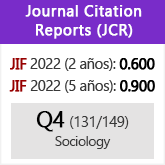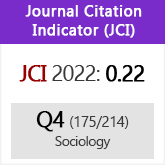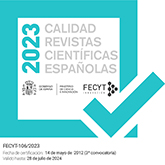Anillos de crecimiento en el árbol de la ciencia. La evolución institucional del Consejo Superior de Investigaciones Científicas
DOI:
https://doi.org/10.3989/ris.2007.07.13Palabras clave:
Cambio organizativo, Centros públicos de investigación, Organizaciones científicas, Política científicaResumen
¿Cuáles son los factores que influyen en los modelos organizativos de los grandes centros públicos de investigación de ámbito nacional? ¿Cómo afectan los cambios a la naturaleza de la actividad científica que realizan? Este artículo utiliza el caso del CSIC para estudiar un proceso de cambio organizativo teniendo en cuenta la tensión entre la dependencia del Estado de estos centros y el alto nivel de autonomía de sus comunidades científicas. El principal propósito es explicar cómo la transformación de la estructura de autoridad, junto a la dependencia de agencias de financiación y evaluación, da lugar a la emergencia de las prácticas de investigación consideradas más legítimas y a una reorientación de la actividad científica del conjunto del organismo. Para ello se realiza una narrativa histórica de la situación del CSIC en el periodo comprendido entre la Transición a la Democracia y los inicios del siglo XXI. La narrativa está informada teóricamente por conceptos del enfoque institucional en la sociología de las organizaciones. Los resultados muestran cómo el CSIC se ha convertido en una organización orientada a la ciencia básica. Las conclusiones ofrecen implicaciones para los estudios sociales sobre la ciencia y para las políticas científicas en este campo.
Descargas
Citas
Alonso, S., Fernández, J. R. y Sanz, L. (2001), “Spanish public research centres’ responses to changes: diversification of funding resources”, en D. Cox, P. Gummett y K. Barker (Eds.): Government Laboratories: Transition and Transformation, Amsterdam: IOS Press, 2001.
Bozeman, B. y Crow, M. (1990), “The environments of US R&D laboratories: political and market influences”, Policy Sciences 23: 25-56. doi:10.1007/BF00136991
Brinton, M. C. y Nee, V. (1998), The new institutionalism in sociology, Stanford, CA: Stanford University Press.
Castro Martínez, E. y Fernández de Lucio, I. (2007), “Iniciativas institucionales e individuales en la creación de estructuras científicas: el caso del Instituto de Tecnología Química”, Arbor 727: 803-819.
CICYT (2007), Estrategia Nacional de Ciencia y Tecnología, Madrid: Fundación Española para la Ciencia y la Tecnología.
CSIC (2005a), Memoria de Actividades 2005, Madrid: Consejo Superior de Investigaciones Científicas.
CSIC (2005b), Plan de Actuación 2006-2009, Madrid: Consejo Superior de Investigaciones Científicas.
Colyvas, J. y Powell, W. (2006), “Roads to Institutionalization: The Remaking of Boundaries Between Public and Private Sciences”, Research in Organizational Behavior 21: 305-53. doi:10.1016/S0191-3085(06)27008-4
Cox, D., Gummett, P. y Baker, H. (eds.) (2001), Government laboratories: transitions and transformations, Amsterdam: IOS Press.
Crow, M. y Bozeman, B. (1998), Limited by design. R&D laboratories in the US Innovation System, Nueva York: Columbia University Press.
Cruz, L., Sanz, L. y Romero, M. (2004), “Convergencia y divergencia en las políticas de ciencia y tecnología de los gobiernos regionales”, Revista Española de Ciencia Política 11: 31-70.
Drori, G., Meyer, J., Ramírez, F. y Schofer, E. (2003), Science in the modern world: institutionalization and globalization, Stanford: Stanford University Press.
Etzkowitz, H. y Leydesdorff, L. (2000), “The dynamics of innovation: from National Systems and ‘’Mode 2’’ to a Triple Helix of university-industry-government”, Research Policy 29 (2): 109-123. doi:10.1016/S0048-7333(99)00055-4
DiMaggio, P. J. y Powell, W. W. (1983), “The iron cage revisited: Institutional isomorphism and collective rationality in organizational fields”, American Sociological Review 48: 147-160. doi:10.2307/2095101
DiMaggio, P. J. y Powell, W. W. (1991), The new institutionalism in organizational analysis, Chicago: University of Chicago Press.
Dooris, M.J. y Fairweather, J.S. (1994), “Structure and culture in faculty work: implications for technology transfer”, The Review of Higher Education 17-2: 161-177.
EURAB-European Research Advisory Board (2005), Research and Technology Organisations (RTOS) and ERA, Final report EURAB 05.037, December 2005.
Fernández Carro, R. (2001), Regímenes políticos y actividad científica, Madrid: Fundación Juan March.
Fernández de Lucio, I., Rojo de la Viesca, J. y Castro Martínez, E. (2003), Enfoque de Políticas Regionales de innovación en la Unión Europea, Madrid: Academia Europea de Ciencias y Artes. Delegación Española.
Fernández Esquinas, M. (2002), La formación de investigadores científicos en España, Madrid: Centro de Investigaciones Sociológicas.
Fernández Esquinas, M., Pérez Yruela, M. y Merchán Hernández, C. (2006), “El sistema de incentivos y recompensas en la ciencia pública española”, en Sebastián, J. y Muñoz. E. (Coords.): Radiografía de la Investigación Pública en España, Madrid: Biblioteca Nueva.
Funtowitz, S. y Ravetz, J. (1993), “The emergence of postnormal science”, en Von Schomberg, R. (ed.): Science, Politics and Morality: Scientific uncertainty and decision making, Dordrecht: Kluwer.
Gangutia Elícegui, E. (2007), “El Diccionario Griego-Español”, Arbor 727: 749-769.
Gibbons, M. et al., (1994), The new production of Knowledge, Londres: Sage.
Godin, B. (1998), “Writting performative history: the New Atlantis?”, Social Studies of Science 28: 465-483. doi:10.1177/030631298028003004
Gouldner, A. (1959), “Cosmopolitans and locals: toward an analysis of latent social roles”, Administrative Science Quarterly 2: 281-306. doi:10.2307/2391000
Guldbransen, M. (2000), “Between Scylla and Charybdis –and enjoying it?: Organizational tensions and research work”, Science Studies 13 (2): 52-76.
Hackett, E. (2001), “Science as a vocation in the 1990’s: the changing organizational culture of academic science”, en Croissant, J. y Restivo, S. (Eds.): Degrees of compromise. Industrial interests and academia values, New York: SUNY Press.
INE (2005), Estadística de Investigación Científica y Desarrollo Tecnológico, Madrid: Instituto Nacional de Estadística.
Jang, Y. (2000), “The worldwide funding of ministries of science and technology”, 1950-1900, Sociological Perspectives 43 (2): 247-270.
Jepperson, R. (2002), “The Development and Application of Sociological Neoinstitutionalism”, en Berger, J. y Zelditch, M. (Eds.): New Directions in Contemporary Sociological Theory, Nueva York: Rowman & Littlefield.
Kleinman, D. y Valias, S. (2001), “Science, capitalism and the rise of ‘knowledge worker’: The changing structure of knowledge production in the United States”, Theory and Society 30 (4): 451-492. doi:10.1023/A:1011815518959
Latour, B. y Woolgar, S. (1982), La construcción de los hechos científicos, Madrid: Alianza Editorial.
López García, S. (1999), “El Patronato Juan de la Cierva (1939-1960). III Parte”, Arbor 637: 1-32.
López Facal, J., Ugalde, U., Zapata, A. y Sebastián, J. (2006), “Dinámica de la política científica española y evolución de los actores institucionales”, en Sebastián, J. y Muñoz. E. (Coords.): Radiografía de la Investigación Pública en España, Madrid: Biblioteca Nueva.
Martin, B. y Etzkowitz, H. (2000), “The origin and evolution of the university species”, VEST 13 (3-4): 9-34.
Moore, K. (1996), “Organizing integrity: American Science and the creation of Public Interest Organizations”, 1955-1975, American Journal of Sociology 101 (6): 1592-1627. doi:10.1086/230868
Muñoz, E. y García Arroyo, A. (2006), “El nacimiento de la Ley de la Ciencia: el sueño del progreso”, Revista Madri+d, Diciembre de 2006: 21-25.
Muñoz, E, y Ornia, F. (1987), Ciencia y Tecnología: una oportunidad para España, Madrid: Aguilar
Nieto, A. (Ed.) (1982), Apuntes para una política científica, Madrid: Consejo Superior de Investigaciones Científicas.
Nowotny, H., Scott, P. y Gibbons, M. (2003), “Introduction: `Mode 2’ Revisited: The New Production of Knowledge”, Minerva 41, 3: 179-194. doi:10.1023/A:1025505528250
Owen-Smith, J. (2007), “Structural components of institutional change: the shifting field of play for science and commerce in academe”, mimeo.
Owen-Smith, J. y Powell, W. (2001), “Careers and contradictions: faculty responses to the transformation of knowledge and its uses in the life sciences”, in Research in the Sociology of Work 10: 109-140.
Patronato Juan de la Cierva (1974), Criterios para la Planificación y Programación de Actividades, Madrid: CSIC.
Polanyi, M. (1962), “The Republic of science: Its political and economic theory”, Minerva, 1: 54-73. doi:10.1007/BF01101453
Porter, K., Bunker, K. y Powell. W. (2005), The Institutional Embeddedness of High-Tech Regions, in S. Breschi and F. Malerba (Eds.): Clusters, Networks, and Innovation. Oxford University Press.
Powell, W. (2007), “The New Institutionalism”, en The International Encyclopedia of Organization Studies, Thousand Oaks, CA: Sage Publishers.
Powell, W., Koput, K. y Smith-Doerr, L. (1996), “Inteorganizational collaboration and the locus of innovation: networks of learning in biotechnology”, Administrative Science Quarterly 41: 116-145. doi:10.2307/2393988
Primo Yúfera, E. (1990), “Transición en el CSIC”, Arbor 529: 49-60.
Puig-Samper, M. A. (Coord.) (2007), Tiempos de Investigación. JAE-CSIC: 100 Años de Ciencia en España, Madrid: Consejo Superior de Investigaciones Científicas.
Sanz, L. (1996), Estado, ciencia y tecnología en España, Madrid: Alianza.
Sanz, L. y Cruz, L. (2003), “Coping with environmental pressures: public research organizations responses to funding crisis”, Research Policy 32 (8): 1293-1308. doi:10.1016/S0048-7333(02)00120-8
Scott, R. (2001), Institutions and organizations (Second edition), Thousand Oaks, CA: Sage.
Scott, R. (2005), “Institutional theory: contributing to a theoretical research program”, en Smith, K. y Hitt, M. (Eds.): Greats minds in management: The process of theory development, Oxford: Oxford University Press.
Searle, J. (2005), “What is an Institution?”, Journal of Institutional Economics 1(1): 1-22. doi:10.1017/S1744137405000020
Sebastián, J. y López Facal, J. (2007), “Transición y cambio en el CSIC”, en Puig-Samper, M. A. (coords.) op. cit.
Sebastián, J. y Muñoz. E. (Coords.) (2006), Radiografía de la Investigación Pública en España, Madrid: Biblioteca Nueva.
Shinn, T. (2002), “The Triple Helix and New Production of Knowledge: Prepackaged Thinking on Science and Technology”, Social Studies of Science 8, Vol. 32: 599 - 614.
Schneider, M. y Clemens, E. (2006), “The typical tools for the job: Research strategies in institutional analysis”, Sociological Theory, Nº. 24, pp. 195-227.
Tortosa, E. (1991), “La tecnología de alimentos”, en López Piñero, L. (Ed): España: Ciencia, Madrid: Espasa.
Tortosa, E. (2006), “La I+D en el marco autonómico”, en Sebastián, J. y Muñoz. E. (coords.) op. cit.
Vence, J. y J. Heijs (2006), “Estructura y flujos de la financiación de la I+D en España”, en Sebastián, J. y Muñoz. E. (Coords.) op.cit.
Weingart, P. (1997), “From ‘finalization’ to ‘Mode 2’: old wine in new bottles?”, Social Science Information 36: 591-613. doi:10.1177/053901897036004002
Weingart, P., Krücken, G. y Hasse, R. (1997), “Ciencia y entorno social: una aplicación del enfoque neoinstitucionalista a los estudios sociales de la ciencia”, Revista Internacional de Sociología 16: 117-137.
Ziman, J. (1996), “Postacademic science: constructing knowledge with networks and norms”, Science Studies, Nº 9.
Zucker, L. (1987), “Institutional Theories of Organization”, Annual Review of Sociology 13: 443-464. doi:10.1146/annurev.so.13.080187.002303
Descargas
Publicado
Cómo citar
Número
Sección
Licencia
Derechos de autor 2009 Consejo Superior de Investigaciones Científicas (CSIC)

Esta obra está bajo una licencia internacional Creative Commons Atribución 4.0.
© CSIC. Los originales publicados en las ediciones impresa y electrónica de esta Revista son propiedad del Consejo Superior de Investigaciones Científicas, siendo necesario citar la procedencia en cualquier reproducción parcial o total.Salvo indicación contraria, todos los contenidos de la edición electrónica se distribuyen bajo una licencia de uso y distribución “Creative Commons Reconocimiento 4.0 Internacional ” (CC BY 4.0). Puede consultar desde aquí la versión informativa y el texto legal de la licencia. Esta circunstancia ha de hacerse constar expresamente de esta forma cuando sea necesario.
No se autoriza el depósito en repositorios, páginas web personales o similares de cualquier otra versión distinta a la publicada por el editor.

















